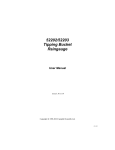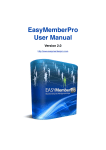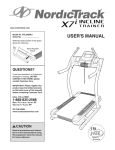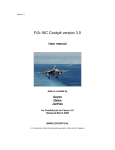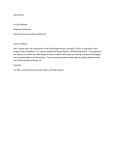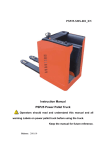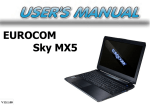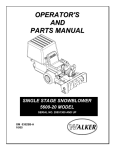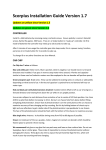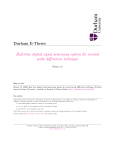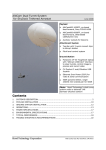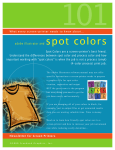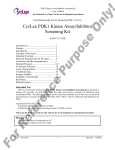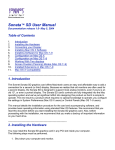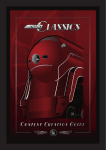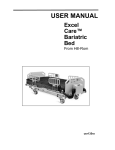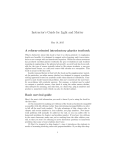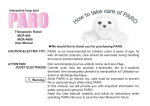Download Final Report - Mechanical Engineering Department
Transcript
Letter of Transmittal: April Final Report Team #13, TITAN All-Terrain ROV To: Dr. Ya-Jun Pan From: Team #13, TITAN ROV K. Brock Gillis Peter Davidson Emmy Schnepf Neala MacDougall Date: Wednesday, April 9, 2008 The goal of Project TITAN was to design and construct an ROV platform capable of carrying a payload over varying terrain. The focus of the TITAN project was on the design and creation of the ROV platform and the maximization of its mobility, durability and reliability. It was these three core concepts that enabled the TITAN to reach almost all of its design requirements successfully. Attached is a report outlining the design process, schedule, final budget, construction and test results of the Gemini ROV. TITAN ROV Team #13 Peter Davidson _______________________________________ Brock Gillis _______________________________________ Neala MacDougall _______________________________________ Emmy Schnepf _______________________________________ Abstract This report outlines the design process that has taken place for the Gemini ROV by Team Titan (Team #13). It begins with outlining the scope of the project, clarifying the TITAN’s focus on mobility in varying situations. Several design alternatives are presented with an appropriate matrix displaying qualities of all options. The design “Gemini” was selected due to its superior mobility and payload capability. Gemini is explained in detail, being broken down into 5 major components for clarity: frame, articulation system, traction system and electrical. The final construction, budget, test results and overall performance of the constructed ROV are examined in detail. i Table of Contents List of Figures..................................................................................................................................5 List of Tables ................................................................................................................................... 5 1 Introduction...................................................................................................................................1 2 Design Objective...........................................................................................................................2 3 Design requirements..................................................................................................................... 3 3.1 Performance........................................................................................................................... 3 3.2 Size and Weight ..................................................................................................................... 3 3.3 Materials ................................................................................................................................ 3 3.4 Fabrication............................................................................................................................. 3 3.5 Appearance.............................................................................................................................3 3.6 Usage..................................................................................................................................... 4 3.7 Testing.................................................................................................................................... 4 3.8 Funding and Cost ...................................................................................................................4 3.9 Documentation.......................................................................................................................4 3.10 Safety ...................................................................................................................................4 4.0....................................................................................................... Design Process & Alternative designs............................................................................................................................................. 5 4.1 The 4x4 Platform................................................................................................................... 5 4.2 The Six Wheel Articulated Platform......................................................................................6 4.3 The Turtle...............................................................................................................................7 4.4 The Gemini............................................................................................................................ 8 4.5 Design Comparison............................................................................................................... 9 5.0 Design & Construction........................................................................................................ 10 5. 1 Frame.................................................................................................................................. 10 5.1.1 Description....................................................................................................................10 5.1.2 Construction..................................................................................................................10 5.2 Traction System................................................................................................................... 11 5.2.1 Description....................................................................................................................11 5.2.2 Construction..................................................................................................................12 5.3 Articulation System..............................................................................................................13 ii 5.3.1 Description....................................................................................................................13 5.3.2 Construction..................................................................................................................13 5.4 Electrical System................................................................................................................. 13 5.4.1 Description....................................................................................................................14 5.4.2 Construction..................................................................................................................14 6 Testing and Results ..................................................................................................................... 16 7 Cost Analysis .............................................................................................................................. 18 7.1 Frame................................................................................................................................... 19 7.2 Traction................................................................................................................................ 19 7.3 Articulation System..............................................................................................................19 7.4 Electrical System................................................................................................................. 19 7.5 Miscellaneous ...................................................................................................................... 20 8 Lessons Learned......................................................................................................................... 21 9 Future Considerations .................................................................................................................23 10 Conclusion................................................................................................................................ 25 APPENDIX A: User Manual and Troubleshooting Guide............................................................ 26 MAINTENANCE & REPAIR....................................................................................................... 27 TREAD REPLACEMENT ........................................................................................................27 GEAR MAINTENANCE.......................................................................................................... 28 CHUCK TIGHTENING............................................................................................................ 28 BATTERY CHARGING & CHANGING ................................................................................. 28 SYMPTOM: MOTOR FAILING TO ENGAGE SHAFT ......................................................... 29 SYMPTOM: ROV UNRESPONSIVE TO CONTROL PANEL...............................................29 SYMPTOM: SMOKE................................................................................................................29 THE CONTROL PANEL.......................................................................................................... 30 Drive - reverse........................................................................................................................... 31 Articulation................................................................................................................................ 31 Turn............................................................................................................................................31 Turning the ROV is not recommended when it is in the unfolded position. The optimal turning position is a “V” configuration. Turning can also be attempted in the folded up position depending on the terrain (i.e. the “V” configuration should be used on loose surfaces and the folded up position should be used on hard, smooth surfaces). Once a turning position has been iii attained, turning is accomplished by pushing the left switches forward and the right switches backwards, or vice versa. ...........................................................................................................31 Obstacle Negotiation................................................................................................................. 31 APPENDIX B: Gantt Chart ...........................................................................................................34 APPENDIX D: Master Parts List .................................................................................................. 36 APPENDIX E: Engineering Drawings ..........................................................................................38 iv List of Figures Figure 1 - 4x4 Platform Isometric........................................................................................................ 5 Figure 2 - Six Wheel Articulated Platform Isometric............................................................................. 6 Figure 3 - Turtle Isometric.................................................................................................................. 7 Figure 4 - Gemini unfolded................................................................................................................. 8 Figure 5 - Gemini Isometric ................................................................................................................ 8 Figure 6 - Frame with Motors............................................................................................................10 Figure 8 - Traction Isometric Exploded.............................................................................................. 11 Figure 7 - Traction Isometric............................................................................................................. 11 Figure 9 - Articulation Isometric........................................................................................................13 Figure 10 - Electrical Schematic........................................................................................................ 14 List of Tables Table 1 - Design Comparison Matrix ................................................................................................... 9 Table 2: Design Requirements and Testing Results............................. Error! Bookmark not defined. v 1 Introduction The purpose of project TITAN was to create a versatile remotely operated vehicle (ROV) which would be able to navigate difficult and varying terrain. The ROV would overcome complex obstacles such as vertical ledges and stairs. The ROV would accomplish these tasks while carrying a payload, such as sensor equipment or a robotic manipulating arm. The TITAN project was focused on mobility; thus only the mass and placement of the payload was to be considered. The aim of TITAN Project was to create an ROV that would be able to go where normal “off the shelf” ROVs canʼt. This allows the ROV to carry payload to normally inaccessible and dangerous areas where humans canʼt venture. 1 2 Design Objective The goal of Project TITAN was to design and construct an ROV platform capable of carrying a payload over varying terrain. The ROV was designed to fulfill many different roles as the payload determines the ROVʼs function. If the payload consists of sensor equipment, the TITAN could be used for reconnaissance or research while if the payload is a robotic manipulator it could be used for bomb disposal. Thus the focus of the TITAN project was on the design and creation of the ROV platform and the maximization of its mobility, durability and reliability. It is these three core concepts that enable the TITAN to carry its payload wherever it needs to go. 2 3 Design requirements The design requirements have been selected to quantify the design objective. They have been grouped into sections below depending on their effect on the design of the vehicle. Later we will examine how the ROV performed in comparison to these requirements. 3.1 Performance While carrying its 10kg payload, the ROV will accomplish a speed of ten kilometers per hour on flat level terrain. It shall also be able to turn within a meter and climb a slope of at least 30°. The vehicle will be able to drive forward on a banking of 20° or more without toppling over. It shall be able to scale a 15 centimeter vertical ledge. 3.2 Size and Weight The ROV will fit inside an 800 by 1200 millimeter footprint. The ROV will be designed to be as light as possible and shall not exceed 75 kilogram. The ROV shall have a ground clearance of at least 50 millimeters. 3.3 Materials The vehicles main structure will be constructed from aluminum. Other sections shall be constructed of material based on applicable properties and cost analysis. Non-essential components will be fabricated from material chosen to reduce weight and cost while maintaining. 3.4 Fabrication A single functioning full size prototype will be manufactured. 3.5 Appearance Because the emphasis for the TITAN Project is on mobility, durability, and reliability, vehicle aesthetics are a tertiary consideration. 3 3.6 Usage The ROV will be controlled by a wireless remote from a minimum of 30 meters and will require little training to operate. The vehicle will be operable for three hours with an interchangeable power supply. It will be capable of operating on pavement, grass, gravel, slick ground and though light shrubbery such as a forest floor environment. The body itself will be water resistant. 3.7 Testing All aforementioned performance specifications will be tested in a real world arena. Upon meeting these specifications the device will be tested to non-destructive limits. The results of this testing can be seen in a later section. 3.8 Funding and Cost The cost of the prototype will not exceed the allotted budget. This includes the controller unit. The main financial support will come from the Mechanical Engineering Department of Dalhousie University. 3.9 Documentation A User Manual will also be prepared. This manual will explain how to control the vehicle, as well as how to perform basic service. 3.10 Safety When the vehicle is completed there will be no unnecessarily exposed moving or electrical parts. Also all members of the team will abide by the Design Project Safety Requirements outlined in the Design Project Handbook (2007-2008) 4 4.0 Design Process & Alternative designs The core design objective of the TITAN project was to maximize its all-terrain capability. In considering this, designs were produced with an emphasis on maneuverability, obstacle negotiation and self-righting ability. Several designs were produced, with four main contenders for the final design selection. Each of the designs differed considerably in satisfying the design requirements though they all employed either wheels or tank-style treads. The four finalists were the 4x4 Platform, the Six Wheel Articulated Platform, the Turtle and the Gemini. After evaluating each of these designs based on cost, all terrain capability, constructability and payload capability it was determined that the Gemini design was most suitable. The following sections contain a breakdown of the four designs and a comparison of their anticipated abilities. 4.1 The 4x4 Platform The 4x4 Platform design, shown in Figure 1, is a simple ROV with four large, powered, multiterrain wheels. The 4x4 platform includes a basic body (shown in blue) with a ramped front and rear for overcoming small objects. This body would also contain the power system for the ROV. The payload would either be carried on top or inside the body. The all terrain capability of this device is almost entirely dependent on wheel size and tread and the output power of the motors. The device would be highly maneuverable due to its skid-steer system using to sets two sets of independently powered wheels. Its maneuverability is further Figure 1 - 4x4 Platform Isometric enhanced by its ability to operate inverted and in reverse. The main advantages of this approach are its large area for carrying payload and its rudimentary, low cost design. However, this design would have trouble 5 negotiating large obstacles, such as vertical ledges or rocks. Due to its lack of articulation and minimum number of wheels it will easily become ‘hung-up’ on large edges. 4.2 The Six Wheel Articulated Platform The all terrain capability of this platform is highly dependent on its two piece, articulated design with a reduced emphasis on wheel traction and power. Articulation is powered by a motor attached to the pivot linkage, shown in Figure 2. The articulation system allows the device to adjust the angle between the two body pieces allowing it to negotiate obstacles. One segment of the device will house the motors and batteries which creates a weight distribution such that the device doesn’t tip with changing articulation angles. This enables the platform to adjust its pivot angle and maneuver in that position and allows it to ‘climb’ over large objects. All six wheels would be powered independently which further increases all terrain capability as well as allowing the device to operate in reverse. Wheel selection would be such that adequate traction is achieved on rough, wet, slick, and/or loose terrain. Figure 2 - Six Wheel Articulated Platform Isometric Payload would be stored on top of the main, unarticulated segment and would be unrestricted by height. Payload restrictions include width, length, weight and orientation such that it does not interfere with the articulating arms. Disadvantages of this design include its potential to become hung up between the sets of wheels on large obstacles. The device is non-invertible and non-self-righting. In other words if the device were to flip itself on rough terrain it would require manual lifting and may cause damage to unprotected payload. 6 4.3 The Turtle The Turtle design features a single platform with four articulated ‘flippers’, shown in Figure 3 The driving power is distributed such that treads on one side of the device act simultaneously but independent of the other side. The treaded ‘flippers’ allow the ROV to maximize traction by increasing Figure 3 - Turtle Isometric the powered surface contact. The ROV can also orient the ‘flippers’ to minimize surface contact and maximize maneuverability. The articulation system is synchronized in a similar way, however instead of left and right sides being independent, the front and back are independent. The front and back ‘flippers’ allow the ROV to pull itself up onto, and over obstacles. The articulation is driven using a worm gear setup which will allow the ROV to have pressure applied to it without fear of back-driving the motor, this will aid in “grabbing” surfaces with the treads to climb over them. This overall design allows the device to be self-righting and invertible. As well, the motors allow the device to be driven in reverse. Payload capability is limited by width, length and weight. Height of the payload is not limited, however, after at certain height (that which coincides with the tread height) the device is no longer invertible and self-righting capability is compromised. In this case, if the device were to tip upside down, it may have to be manually lifted and damage may occur to unprotected payload. 7 4.4 The Gemini The final design, Gemini, is powered by four tank-style treads. These treads are mounted on two body segments which are connected through an articulation system somewhat similar to that of the Six Wheeled Articulated design. Unlike the Six Wheeled design which employed two articulating arms and one motor, this articulation system employs two motors, one mounted on each body segment, and one articulating arm. This allows for a much larger articulation range. Power is delivered from these motors through a worm gear assembly which allows the device to hold certain angles between the body sections without fear of the articulation system being back-driven. Figure 4 - Gemini Isometric For instance the ROV will be able to lift and push itself upward and onto ledges. This articulation system also enables the ROV to change its form; folding up to move in tight spaces, as in Figure , and stretching out to increase surface contact and lower the center of gravity, shown in Figure . Having a lower center of gravity enables the ROV to climb steeper inclines. In the stretched out position, the Figure 5 - Gemini unfolded increased driven surface area increases the devices ability to negotiate loose and/or slick terrain. Driving power is provided to the treads by four motors, two per segment allowing each tread to act independently of the others. This gives the device skid steering capabilities. 8 Payload on the Gemini is held in two payload bays installed within the ROV. While these bays limit the volume and weight of the payload, they provide protection when the device is in operation. 4.5 Design Comparison In determining the most appropriate design given the design requirements discussed in section 3, the following matrix, Table 1 was constructed. This matrix quantifies how each device was expected to perform given several major design parameters. Each design parameter was given a weight, or a maximum score, that is indicative of its importance in the overall design. Each design can score from 0 to the maximum score for each parameter. The results are shown in Table 1. Criteria Weight Design 1 Design 2 Design 3 Design 4 Terrain Mobility 10 4 6 8 10 Obstacle Navigation 10 2 4 6 10 Payload Capability 9 9 6 8 8 Invertible 8 4 0 8 8 Self Righting 8 0 0 8 8 Ease of Maintenance 7 7 6 4 6 Ease of Manufacture 6 6 5 6 6 Overall Cost 6 6 6 4 6 Total 64 38 33 52 62 Table 1 - Design Comparison Matrix Design four, Gemini, scored the highest in the design comparison matrix due to its superiority in nearly every category. Gemini was the selected design, and all further consideration is with respect to its design. 9 5.0 Design & Construction The final Gemini design consists of 4 primary areas. These are described below by section for clarity. A full parts list can be found in Appendix C. 5. 1 Frame The frame allows the connection of the multitude of assemblies into a functional vehicle. It is analogous to the ‘backbone’ of the design. A frame section can be seen in Figure 6. 5.1.1 Description The frame acts as the interface for the assemblies that make up each body section. The motors, electronics, track assemblies, and articulation system all attach together through the frame. There are two frame assemblies within the ROV, one for the bottom section and one for the top section. While both these assemblies are nearly identical, the bottom section houses the battery packs while the top section houses any potential payload. 5.1.2 Construction The frame is constructed from 1” square aluminum tubing. This tubing was cut to lengths and welded together by a mechanical department technician. 10 5.2 Traction System The vehicle is propelled by four tank-style treads attached to the two main body sections. The treads provide a “terrain grabbing” surface which allows the vehicle to climb over obstacles while maintaining surface contact. Tread propulsion virtually eliminates the risk of the device becoming ‘hung-up’ on obstacles passing underneath. 5.2.1 Description Each track assembly consists of; one driven wheel, a set of bogey wheels and one tensioning wheel. These wheels are sandwiched between two track panels, as illustrated in Figure 6 and Figure 8. The panels were initially to be constrained by two track panel spacers, but now are separated by a fixed inter-panel member, illustrated in grey in Figure 8. The bogey wheels were to be located around the track panel but now exist only on the lower track, one at each corner. These wheels all contain internal bearings to reduce rotating friction. Each track Figure 6 - Traction Isometric assembly is powered by the driven wheel which is located at the top outside corner and connected directly to the driving motor. The tensioning wheel located at the top inside corner will be able to move in a linear motion constrained within a slot, to tension the treads. This allows for quick tread tension adjustments should it be required for specific terrain or as a result of stretched tread. This type of tensioning makes tread mounting quick and easy. The treads themselves are wrapped around the driven, tensioning and bogey wheels to provide a powered contact surface with the ground. Figure 5 - Traction Isometric Exploded 11 5.2.2 Construction The treads are fabricated from 3” meat cleat conveyor belt that was purchased from Snowdon Rubber, in Dartmouth, Nova Scotia. The treads were purchased and then cut to length. They were fused by Snowdon at a length of 1500 mm. The track panels are fabricated from ¼” aluminum sheets. These were machined in the Mechanical Engineering Department Machine Shop. The rigid inter-panel member was also fabricated in the M.E. Dept Machine Shop from 1" Aluminum square tubing and 1"x1/8" Aluminum flat bar. The drive, tension and bogey wheels were manufactured from 3” aluminum round bar and machined at the CNC (Computer Numerical Control) CAD-CAM group at Dalhousie University. The axles for the tensioning drive and bogey wheels are attached to both the inside and outside panels via a modified nut and bolt system. 12 5.3 Articulation System Joining the two body sections together is the articulation assembly. This system allows the folding of the vehicle. A model of the articulation system can be seen in Figure 9. 5.3.1 Description The articulation system is responsible for folding and unfolding the ROV. This system attaches to each of the body sections though their respective frames. Each of the two ends of the articulation system contains a motor and a worm gear reduction system. These gear systems connect together through two steel articulation arms. This dual connection allows the ROV to alter its shape and weight balance to overcome obstacles. It also allows the vehicle to fold one set of tracks onto the other so that only two of the four drive motors need to be operating. This allows for greater battery life as well as the protection of Figure 7 - Articulation Isometric the electronics and payload. 5.3.2 Construction Consisting of two ½” steel axles mounted on aluminum pillow blocks, each side of the articulation system transfers power from its motor though a worm gear drive to a pair of spur gear stacks. The spur gears have a gear reduction ratio of 3:1 and the worm gear assembly has a gear reduction ratio of 30:1. This entire assembly is connected through aluminum pillow blocks to the frame of each body section. The motors for the articulation assembly are modified Ryobi 18V cordless impact drill motors. These motors were chosen for their high torque capability and small size. As well, the original drill chuck was used to mount the drive shafts and ease assembly and maintenance. 5.4 Electrical System 13 5.4.1 Description The electrical system feeds power from the batteries to the motors through a tethered operator control panel. The control panel allows the vehicle’s motion and articulation to be controlled from a distance of several feet. The wiring is illustrated in Figure 10. Each track assembly is powered with one motor, while each side is controlled as a pair. Each half of the articulation system has its own motor and is controlled independently. The batteries and the tether are secured to the lower body assembly. Figure 8 - Electrical Schematic 5.4.2 Construction All of the electrical components were purchased according to their availability and cost effectiveness. Every effort was made for the ROV to be operated remotely, but tethering the ROV was necessary to lower the cost of the prototype. The motors are 18V cordless drill motors. These are used due to their high torque and relatively low cost. Each motor came with a charger and two batteries. The following is an approximate calculation for torque required from the motors which drive the articulation system. Maximum Force (Fm) at furthest point during articulation = W / 2 = 395N where W is the maximum weight of the device. Torque (T) on first shaft = F * d = 0.7m * 395N = 275Nm Torque (T) on second shaft = T * GR = 275Nm * (1/3) = 95Nm where GR is the implemented gear ratio. 14 Therefore, the required torque of the motors is determined by the gear ratio achieved from the worm gear assembly. After consulting a worm gear manufacturer, it was found that a worm gear assembly can provide the appropriate gear ratio for a typical 18V (~50Nm) drill motor to overcome this torque. 15 6 Testing and Results Testing was done a continuous basis during construction and assembly to investigate the functionality of several components including the tracks, drill motors and electronics. Major testing of the completed allterrain ROV was performed on three occasions. The initial primary fundamentals test was completed on March 24th, 2008. This test was conducted using the new tethering system operated by Peter Davidson, and supervised by Albert Murphy. The primary purpose of this session was to confirm basic functionality: ability to drive in forward and backward directions, ability to articulate the body, ability to turn in a small radius and ability to negotiate a five inch diameter object. This test was successful in most respects. The ROV was capable of articulating, driving and climbing over the object. Difficulties arose when the ROV tried to turn in a small radius. As the ROV attempted to turn within a tight radius, one of the lower tracks on the inside of the turn resisted motion, causing the motor driving that track to stall and smoke. This was attributed to the ground friction (surface was smooth stone) and the team made the decision to test the same maneuver on a loose gravel surface. The ROV was tested again on March 25th, 2008 in the parking lot adjacent to Queen Street, Halifax, Nova Scotia. The test was supervised by Albert Murphy, Angus Macpherson and Dr. Pan. This testing session was conducted to see how the ROV would perform on a loose gravel surface and on snow. In addition, the top straight line speed was tested, as well as the basic maneuverability. Overall the ROV performed very well. The top speed was marked at 1m/s (3.6km/hr) which was significantly lower than the ambitious required speed of 10km/hr. The ROV performed well in straight line and obstacle maneuvering testing, again easily negotiating the five inch diameter object. Turning on a gravel surface was also much easier and the loose surface allowed the track on the inside turn radius to move and not resist motion. This session also determined that the ROV will turn much easier in a “V” like position rather than the standard folded position. It also became apparent that the operation of the ROV depends heavily on the ability of the operator. The operation manual created will help to advance an operators knowledge extensively. The third testing session was held on April 1, 2008. The purpose of this session was to operate the ROV on a grass surface, and to determine the banking and slope capabilities. The ROV was also weighed during this session. Weather conditions were rainy. The ROV operated extremely well and outperformed itself compared to other sessions. We were able to test the banking and slope driving, as well as driving the ROV in slush/snow. The ROV also operated consistently for 30 minutes (until batteries were fully drained). The following table displays the design requirements in comparison to our testing results. Overall, we were very pleased with the outcome and reliability of the ROV. 16 Table 2: Design Requirements & Results DESIGN REQUIREMENT OUTCOME COMMENTS Carry a 10kg payload Operates easily with this load. PASS Speed of 10km/hr in a straight line Speed of 3.6km/hr achieved FAIL Turning radius of 1 m Climb an incline of 30 degrees Turning radius of 0m (Turns on the spot) PASS PASS Issues with low quality drills and lack of power did not enable us to achieve our maximum desired speed. Turning radius is better than required. The ROV easily climbs this incline The ROV easily drives on this bank The ROV easily articulates over this ledge Drive on a banked slope of 20 degrees Scale a 15 cm vertical ledge PASS 800x1200 mm footprint The ROV has a footprint of 660x 635mm PASS The mass of the ROV is 140 lbs The ROV could be created even (approximately 64 kg) lighter. Materials could be PASS removed from the insides of the bogey wheels as well as articulation arms The ROV has a ground clearance It is clear that the clearance is not of 40 mm. significant, as the ROV can easily FAIL just articulate over objects when it gets “hung up” The body is constructed of Al PASS Materials were chosen to be cost Some materials could not be effective (inexpensive drill compromised for safety reasons, motors, inexpensive track i.e. certain gauges of wiring, other material, lightweight aluminum electrical components) frame) PASS Not exceed 75 kg, while being as light as possible Ground clearance of 50mm Main structure constructed from aluminum Materials chosen to be lightweight and cost effective PASS Single, fully functional prototype created A functional ROV which passed department inspection was created PASS Controlled from a wireless remote, A tether system was implemented 30m away with little operator with an operating range of 3 feet training CONDITIONAL 17 Model created was a 1/3 model of the initial proposed design Due to electrical difficulties and the destruction of some design components during testing, a tether system was adopted to be able to meet requirements within time and finances. Future time and further funds would allow for remote implementation. Operable for 3hrs with interchangeable batteries Operable on grass, gravel, slick ground, light shrubbery Operable for 15-30 minutes per battery set. Two battery sets enables the ROV to be operated for 30 minutes to 1 hour depending on usage. CONDITIONAL Operates on grass, gravel and slick ground CONDITIONAL A 3 hour operational time was an optimistic estimate. It could be achievable with having either more battery sets or higher capacity batteries. The ROV was tested on wet ground as well as slushy ground without problem. We were unable to test on light shrubbery due to time and weather constraints. Water resistant body The ROV and its electronic With more time, water resistant components are in no way coverings could be applied to the protected from water, however it electronics, particularly if a was tested in rain and through remote control system was snow and operated successfully implemented. CONDITIONAL Constructed within budget of $3800 Design Team #13 was required to Due to some poor decision use$162.67 of personal funds to making and testing destruction, complete the project the design team #13 was required CONDITIONAL to contribute funds to pass inspection. In future, the ROV could be constructed with the $3300 limit. Users manual created A user manual has been created with basic maintenance, troubleshooting guide and basic operation instructions. PASS Construction done within One minor incident was reported The incident was not a result of department safety regulations to the department disregarding safety regulations PASS and was accidental in nature. 7 Cost Analysis The Dalhousie University Department of Mechanical Engineering in conjunction with Shell Canada has provided our team with $3800.00. The “TITAN” all- terrain ROV prototype belongs to the department and the intellectual property will belong to the group members of Team #13 equally. Team #13 did its best to try and remain within the allocated funds, but did finish $162.67 over budget. This overdraft can be attributed to a combination of poor decisions with respect to the motors as well as the control system change. 18 7.1 Frame The frame is constructed out of aluminum tubing and aluminum plating. These materials were purchased primarily from Metals “R” Us in Dartmouth, Nova Scotia and were on budget. 7.2 Traction The traction system is constructed from “meat cleat” conveyor belt purchased from Snowdon Rubber in Dartmouth, Nova Scotia and was an inexpensive component of the ROV with a total cost of $372.90. More significant was the cost of the pulleys that the belt rides on. The pulley material was purchased from Metals “R” Us for $248.60 and machined in the CAD-CAM office at Dalhousie University for $560.00. This system cost less than the initial belt/pulley system constructed from double sided timing belt and was chosen due to its cost effectiveness. 7.3 Articulation System The articulation system is composed of several spur gear sets and worm gear sets which were bought stock from Motion Canada at a cost of $562.80. This is an expensive component however the articulation system is the primary feature of the ROV and funds were allotted for quality gears. 7.4 Electrical System The electrical system composes the most expensive part of the ROV and consists of drill motors, controllers, an RF receiver, servo motors and wiring. The primary budget downfall of Team #13 was in the purchasing of expensive RC equipment which was destroyed in initial testing. Team #13 was required to switch to a tether system which created additional costs. The cost of the unused RC equipment was $687.28 plus some additional wiring costs. A new tether system was created for approximately $75. In addition to the RC equipment, a significant amount of money was spent on 4 impact drivers which were dismantled and then abandoned during a design change. The cost of the unused impact drivers was $447.48. The cost to replace the impact drivers with standard drills was $225.95. In addition, one of the new standard drills was 19 destroyed during testing and needed to be replaced at the cost of $56.49. The cost of these design changes was in total $1435.71 not including a damaged drill replaced during destructive testing. 7.5 Miscellaneous Miscellaneous costs that team #13 incurred were batteries for testing equipment, wire connectors, nuts, bolts, washers and other small components. The cost of these pieces was not significant in the overall budget and was as anticipated by Team #13. 20 8 Lessons Learned During fabrication, testing and troubleshooting of the ROV, Team #13 came across several situations which have resulted in lessons learned. It is believed that these lessons will aid future projects considerably especially those similar to the Gemini ROV. One of the lessons learned which was an issue throughout the project was with regard to purchasing. Firstly, requesting formal written quotes for all purchased material ahead of time is highly recommended. Not doing so resulted in a complete re-design of the traction system when it was realized our original verbal quote for materials was much less than the actual cost. Secondly, it is recommended that all delivery times for materials be investigated thoroughly to ensure against lost time. As well, knowing delivery times, it is recommended that all purchases be made as late as possible for those parts which are subject to change. With regard to motor selection, Team #13 has learned that a single motor should be purchased for each application before all motors are purchased. Motors should be purchased when they are ready for installation and testing to prevent lost monies. The impact drill motors were purchased in bulk and it was only after dismantling them that it was realized that they would not be appropriate as drive motors. They were however appropriate for the articulations system. Another important lesson learned involved utilizing the expertise of experienced technicians. The electronics controlling the ROV is the area which would have benefit most from consulting experienced technicians. Team #13 has limited knowledge of the electronic components that were originally chosen to control the ROV and this resulted in re-designing the control system to include a tether after several failed tests with a remote system. Other components which would have benefit from consultation were the pulleys used in the traction system. Originally the pulleys were crowned and lipped to hold the track in place. However, after testing it was 21 realized that the lips created an area of higher tension and pulled the tracks off the track panel. The pulleys had to be re-machined to take off these lips. One of the final lessons learned was with regard to testing. Testing should only begin after all components (especially electronic) have been thoroughly checked and confirmed. As well, before any official testing is completed, the device should be informally tested ahead of time to allow for required modifications should testing fail. As well, tests should begin with the most basic of operations and work toward the more complicated operations by an experienced operator in an area appropriate for testing. 22 9 Future Considerations Having exhausted both time and funding for the Gemini ROV, Team #13 has come up with several future considerations should the project be continued again in the future. It is believed that the performance of the ROV would be further improved if these suggestions were realized. The first suggestion involves the drive motors for the ROV. The drive motors currently installed are Allied 18V drill motors. These motors were purchased for their voltage and cost effectiveness to suit the existing electronic equipment and the remaining budget at the time. If performance of the motors alone was considered higher quality drills with higher torque rating would have been purchased. Another option would have been to purchase motors with the desired torque rating directly from a motor supplier possibly with shaft encoders which would have allowed for further robotizing of the ROV. The next consideration would be with regard to the traction system. Currently, the ROV employs simple conveyor type belts wrapped around several crowned pulleys. While the crowned pulleys do provide some centering capabilities, they also have a tendency to slip, hindering drive capability. A modification to this would be to utilize double sided timing belts with self centering characteristics or purchase track assemblies fabricated specifically for robotic purposes. Availability and cost prevented Team #13 from employing these options on the existing ROV. The final suggestion involved the control system of the Gemini ROV. Currently the ROV uses a tether system with a rudimentary controller. The controller utilizes toggle switches to control the drive motors and drill triggers to control the articulation motors. A more effective system would be controlled remotely and include speed controllers on all the motors. This option was employed for a short time with the existing ROV but was abandoned after destructive testing left 23 two of the speed controller unusable. Remaining budget and time hindered Team #13 from investigating this control system further. A note should be made with regard to programming the ROV. While this option was not considered for the Gemini ROV, it would be possible to do so if the control system were redesigned in the future. It is believed that this would increase the capabilities of the ROV. 24 10 Conclusion The design and fabrication of the ROV outlined in this report has shown the ability to meet and exceed almost all of the outlined design requirements. It is believed that further developments with regard to drive motor and track selection, while maintaining the original design, would enable the ROV to exceed all design requirements. The mechanical components and design of the ROV have shown exceptional ability in both the original model and full scale fabrication. Design Team #13 would like to thank Dalhousie University’s Department of Mechanical Engineering and Shell Canada for their financial support. We would also like to thank the technicians at Dalhousie University for their help with the design and fabrication processes. Finally, we would like to thank Dr. Pan for her assistance, guidance and enthusiasm for our project. 25 APPENDIX A: User Manual and Troubleshooting Guide 26 USER MANUAL AND TROUBLE SHOOTING GUIDE MAINTENANCE & REPAIR TREAD REPLACEMENT Tread replacement can be broken down into four elementary steps: • Tread de-tensioning o Loosen the nuts on either side of the tensioner wheel, such that the lock washers are disengaged o Slide the axle of the tensioner wheel in its slot such that the tread is loosened • Tread removal o Pull the tread off all four wheels simultaneously o It may be easiest to accomplish this using an incremental approach, moving the tread a few centimeters off each wheel one at a time • New tread attachment o Put the new tread on all four wheels simultaneously o Again it may be easiest to accomplish this using an incremental approach • New tread tensioning o Insert a lever of approximately 1m in length between the tensioner wheel and the nearest bogey wheel o While maintaining force on the lever, have an assistant tighten the nuts on either side of the tensioner wheel. 27 GEAR MAINTENANCE Occasionally the articulation gears acquire debris lodged between their teeth, it is important to check for this and remove any buildup before it has a chance to cause any damage. CHUCK TIGHTENING During normal operation the chucks of the motors may loosen. If the chucks are allowed to loosen significantly the hexagonal shape of the shaft may be damaged; necessitating shaft replacement. Periodically check that the chucks are tight by holding the rim of the chuck and rotating the sleeve clockwise. BATTERY CHARGING & CHANGING After operation it is important to charge the batteries. Each battery is removed individually. To remove a battery, simply pull on the battery while squeezing the yellow tabs on each side. **IF YOU ARE NOT SURE, CONSULT AN EXPERT** 28 TROUBLE SHOOTING SYMPTOM: MOTOR FAILING TO ENGAGE SHAFT This symptom could be attributable to several problems: • Loose chuck o Check that the chuck is tight as described in the maintenance section. • Missing key o Remove the track panel by loosening the corresponding nuts. Visually inspect the exposed end of the drive axle; ensure that the keyway is occupied by an appropriately sized key • Rounded shaft or twisted axle o Remove the drive wheel from the motor chuck and visually inspect the shaft. The shaft should be hexagonal for the first inch. If this section is either rounded or twisted, the shaft will have to be replaced. If it is neither rounded nor twisted reassemble the track plate and re-check the tightness of the chuck. SYMPTOM: ROV UNRESPONSIVE TO CONTROL PANEL Immediately remove batteries! Take note if any of them are hot to the touch. Inspect the wiring for short circuits. If there are no apparent problems, allow the batteries and motors to cool before operating again. SYMPTOM: SMOKE Immediately remove batteries! Smoke indicates that the circuit is overheating. This is likely caused by a stalled or otherwise over-worked motor. The safest course of action is to remove the batteries, allow the circuit to 29 cool, check for short circuits and ensure that no motors were being stalled. Should a motor have stalled for longer than 15 seconds, the motor might need to be replaced. OPERATION THE CONTROL PANEL The control panel features four switches and two triggers. Each of the four switches controls a drive motor, and each of the triggers controls an articulation motor. The switches are arranged such that those controlling the left side of the ROV are on the left side of the control panel and vice versa. The switches controlling the motors on the bottom half of the ROV are more frequently used and thus have been placed at the outside edge of the control panel for quick access. To reduce disorientation, each motor and switch has been color coded. Motors and their respective switches that are colored green control the left half of the ROV, while white motors and switches control the right half of the ROV. Motors and switches to control the bottom half of the ROV have two color strips while those for the top have only one strip. For example motor “double green” is the motor on the bottom left of the ROV, while switch “single white” is the switch which controls the top right motor. 30 BASIC OPERATIONS NOTE: Several ROV positions can be found on the following page Drive - forward Driving forward is accomplished by pushing the switches forward. If the ROV is folded up only the outer switches need to be pushed (these control the lower motors) as the other tracks are not in contact with the ground. Drive - reverse Driving in reverse is accomplished by pulling the switches backward. If the ROV is folded up only the outer switches need to be pulled (these control the lower motors) as the other tracks are not in contact with the ground. Articulation Articulation is accomplished using the triggers conveniently hanging from the control panel. Each trigger controls one motor of the articulation system. Pulling the trigger operates the ‘throttle’ of the motor, and the direction is controlled by the ‘direction selector’ level attached to the trigger. Turn Turning the ROV is not recommended when it is in the unfolded position. The optimal turning position is a “V” configuration. Turning can also be attempted in the folded up position depending on the terrain (i.e. the “V” configuration should be used on loose surfaces and the folded up position should be used on hard, smooth surfaces). Once a turning position has been attained, turning is accomplished by pushing the left switches forward and the right switches backwards, or vice versa. Obstacle Negotiation The most reliable way to scale an object is to orient the ROV such that it is unfolded and the bottom half (the section containing the battery bank) of the ROV is toward the obstacle. The ROV can typically drive half way across the obstacle. Once the ROV has straddled the obstacle, simply articulate the other half of the ROV over the obstacle and drive clear. 31 “V” configuration “open” configuration 32 “closed” configuration 33 APPENDIX B: Gantt Chart APPENDIX C: Budget Items shown in red were purchased by Team #13 and were not eligible for reimbursement due to an over budget APPENDIX D: Master Parts List APPENDIX E: Engineering Drawings












































































